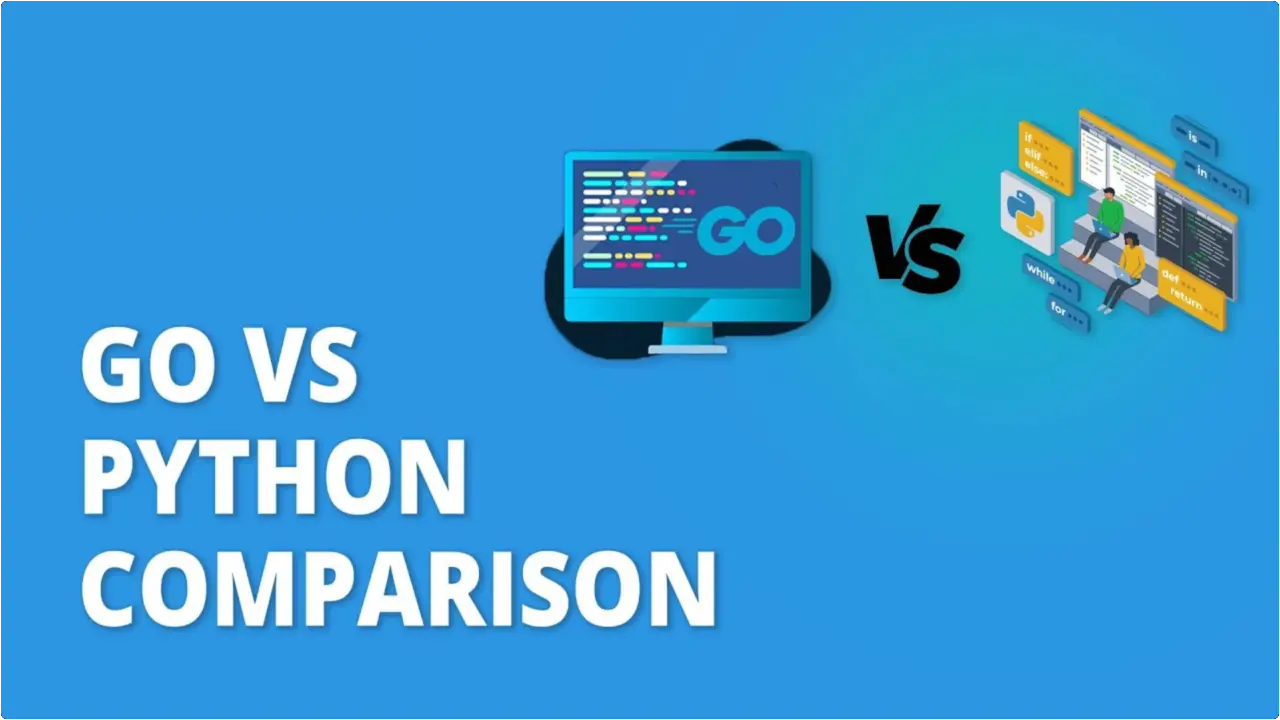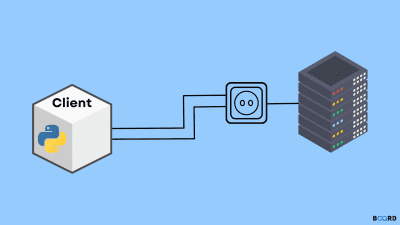Golang Vs Python: Which Language Is Best?
- With Code Example
- March 2, 2024

Series - Golang vs

Go was designed by Google to be a fast, statically typed, compiled language for building simple, reliable and efficient software. Key goals for Go include:
- Fast compile times
- Efficient execution
- Built-in concurrency constructs
- Minimalist and consistent syntax
- Strong typing and compile-time checking
- Excellent support for building networked systems and applications
Python was designed as a general-purpose, interpreted, dynamically typed language focused on code readability and developer productivity. Key design principles for Python include:
- Clear, readable syntax that is easy to learn
- Dynamically typed for flexibility and polymorphism
- Automatic memory management with garbage collection
- Emphasis on code readability
- Extensive libraries and third-party packages
- High-level data types and structures
- Support for multiple programming paradigms
- Portability across platforms and integration with other languages
- Use as a scripting or glue language to connect components
Note
Go was designed for performance, reliability and ease of concurrency while Python was designed for developer productivity, readability, and rapid application development. Both languages are well-suited for their own domains.
Table of Contents
Key differences between Go and Python
Typing
One major difference between the two languages is the typing discipline. Go is a statically typed language, meaning that variables must be explicitly declared with a type and that type is then checked for type-correctness at compile time. This adds safety and runtime performance at the cost of some initial developer flexibility. Python on the other hand is dynamically typed, meaning variable types are inferred at runtime and can change on the fly. This makes Python very flexible but less performant.
Note
- Go is statically typed - variables must be explicitly declared with a type and that type is checked at compile time.
- Python is dynamically typed - the interpreter infers types at runtime and variables can change types on the fly.
Execution model
Another key difference is the execution model. Go code compiles down to optimized native machine code which allows for very fast and efficient execution. The compilation of machine code happens ahead of time before the program runs. Python on the other hand uses an interpreter to execute code line by line. This has some performance costs but allows for very iterative development and fast modification cycles. The interpreter also provides many advanced runtime services like dynamic typing, garbage collection, and support for introspection and metaprogramming.
Note
- Go: Compiled language - code is translated into machine code for faster execution.
- Python: Interpreted language - code is executed line by line, making development faster but potentially slower execution.
Concurrency
Concurrency support is also quite different between the languages. Go has built-in concurrency constructs like goroutines (lightweight threads) and channels which make it easy to write highly concurrent programs. Python supports concurrency via threads but has a global interpreter lock which limits actual parallelism. Performant and robust concurrent programs require more work from Python developers to manage threads and locks. Go’s concurrency model is more modern and lightweight.
Note
- Go Built-in support for concurrency with goroutines and channels, making it ideal for building scalable applications.
- Python: Requires additional libraries for concurrency, which can be more complex to implement.
Syntax
When it comes to syntax, Go uses a C-inspired syntax with curly braces, semicolons and strict formatting rules. This can seem a bit heavyweight coming from dynamic languages but it adds consistency. Python emphasises code readability through the use of whitespace indentation, simple Visual syntax, and dynamic duck typing. This makes Python very approachable for beginners.
Note
- Go: More concise and explicit syntax, similar to C.
- Python: Known for its clean and readable syntax, making it easier to learn.
Standard Library
Finally, the ecosystem and libraries around the two languages are quite different. Go ships with a robust standard library providing utilities for IO, networking, containers, testing and more. Python has fewer batteries included but makes up for it with its massive ecosystem of high-quality third-party libraries and packages. Python’s ecosystem is more mature and comprehensive at this point.
Note
- Go: Smaller standard library focusing on core functionalities.
- Python: Extensive standard library with modules for various tasks, including web development, data science, and machine learning.
Use Cases
Go is often used for:
Building high-performance servers and microservices - Go’s speed, concurrency support and lightweight memory footprint make it well-suited for building responsive and scalable backend services.
Network programming and systems programming - The language provides low-level control and native compilation while still being easy to use which makes it useful for systems and networked systems code.
Concurrent applications - Go’s goroutines and channels make it easy to write highly concurrent programs to take advantage of multi-core processors.
Python is a popular choice for:
Data science and machine learning - Python has become the lingua franca for data analysis and ML with its powerful libraries like NumPy, Pandas, scikit-learn etc.
Web development - Frameworks like Django and Flask combined with Python’s dynamism make web development very rapid.
Scripting and automation - Python’s flexibility, modules and simple syntax allow it to be used for scripting tasks and workflow automation.
Prototyping and rapid development - The interpreted nature and dynamic typing facilitate quick iterations and allow Python developers to build prototypes quickly.
Note
Go is well-suited for performance-critical networking and concurrent tasks while Python shines for scientific computing, web development and rapid iteration. Both languages have their sweet spots based on the use case.
Learning Curve
Python generally has a gentler learning curve compared to Go given Python’s simplicity, intuitive syntax, and emphasis on readability. There is also an abundance of tutorials, documentation, and other learning resources for Python since it has been around for decades. Go has a steeper learning curve as developers coming from dynamic languages have to get used to static typing, compilation, and explicit error handling.
Community and Ecosystem
Both Go and Python have active developer communities and healthy open-source ecosystems. However, Python’s community is among the largest and most vibrant in the world. Its ecosystem is also significantly more mature with libraries for virtually every task imaginable. While Go’s ecosystem is rapidly growing, it still lags behind Python in terms of size and maturity. Overall, Python has an edge when it comes to community support, available libraries, SO answers etc.
Python’s simplicity, abundant resources, and vast ecosystem lower the barrier to entry especially for newcomers to programming. Go trades off some initial learnability for performance gains. For most applications, Python has more readily available libraries while Go forces developers to build more from scratch. Both languages have pros and cons depending on one’s specific background, needs, and application domain.
Conclusion
In summary, Go and Python are both modern, versatile and widely used programming languages. However, they represent very different approaches to software development.
Key differences include Go’s static typing, compilation, inbuilt concurrency constructs and lean syntax - which allow it to run fast and efficiently handle concurrent workloads like backend services. Python on the other hand is dynamically typed and interpreted - making it ideal for quick iteration, scripting, machine learning and feature-rich applications.
Go has a steeper initial learning curve but the strict and simple syntax pays off in larger programs. Python is beginner-friendly and has a gentler learning curve aided by its vast libraries and community.
Both languages have their pros and cons. There is no single best choice - it depends on your specific needs. Go shines for performance-critical tasks that need concurrency, low latency and reliability. Python is better suited for use cases like data analysis, web development and rapid prototyping where developer productivity matters most.
The key is to understand your goals and pick the language that best fits your project requirements, team skills and architectural needs rather than mere personal preferences. With their robust ecosystems and ubiquity, Golang and Python are both safe choices for most applications today.
FAQs
Frequently Asked Questions (FAQs)
- Fast compile times
- Efficient execution
- Built-in concurrency
- Minimalist syntax
- Strong typing
- Excellent for networked systems
- Clear, readable syntax
- Dynamically typed
- Automatic memory management
- Extensive libraries
- High-level data structures
- Support for multiple paradigms
- Portability and integration
- Go: Statically typed, compile-time checking
- Python: Dynamically typed, runtime inference
- Go: Compiled to machine code for speed
- Python: Interpreted line by line
- Go: Built-in concurrency with goroutines
- Python: Concurrency via threads, limited by GIL
- Go: C-inspired with strict formatting
- Python: Readable with indentation, dynamic typing
- Go: Smaller standard library
- Python: Extensive standard library, plus third-party packages
- Go: Servers, microservices, network programming, concurrency
- Python: Data science, web development, scripting, prototyping
- Python: Gentler learning curve, abundant resources
- Go: Steeper learning curve, static typing, explicit error handling
- Python: Larger, mature community, vast ecosystem
- Go: Growing community, smaller ecosystem
- Go: Performance-critical tasks, concurrency, reliability
- Python: Data analysis, web development, rapid prototyping

Related Posts

Documentation and Comments in Go
In the realm of software development, writing code is only half the battle. The other half revolves around creating clear, concise, and comprehensive documentation that not only aids developers in understanding the codebase but also serves as a roadmap for future development.





